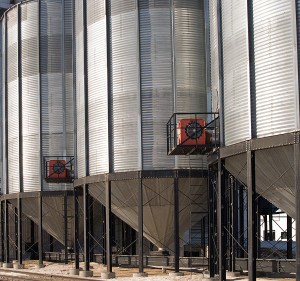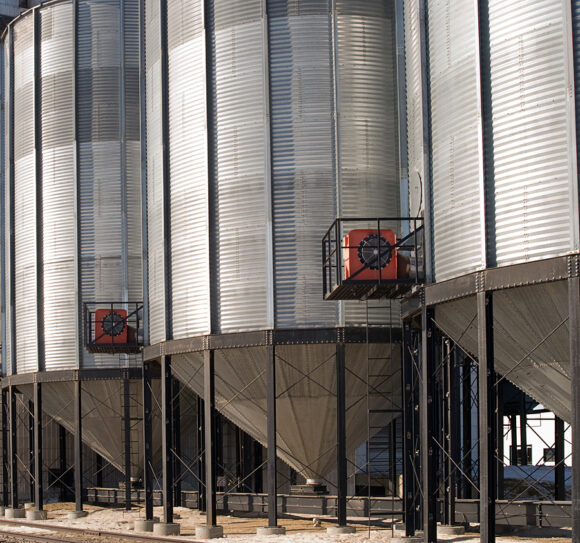The one sure-fire way to avoid dying in a grain bin is to stay out.
That’s where Scott Haugan and some high-tech wizardry come in.
The Des Moines Register reports Haugan, who runs the Howgan grain storage technology firm in Marshalltown, has teamed up with the state’s science and technology apparatus to push the idea of using sensors and remote-control fans to prevent the types of grain-crusting problems that lead farmers to risk their lives by entering grain bins.
 At least two Iowans have been trapped in grain bins in the past month. A Harcourt man, 30-year-old Brandon Tyler Mullen, died July 9 when he was trapped while removing grain in Dayton. Arick Baker, 23, of New Providence was more fortunate, surviving when a mask he wore for asthma bought him time after he got stuck June 26 in Hardin County.
At least two Iowans have been trapped in grain bins in the past month. A Harcourt man, 30-year-old Brandon Tyler Mullen, died July 9 when he was trapped while removing grain in Dayton. Arick Baker, 23, of New Providence was more fortunate, surviving when a mask he wore for asthma bought him time after he got stuck June 26 in Hardin County.
Baker beat the odds. A Purdue University study found that between 1964 and 2008, 74 percent of grain entrapment cases resulted in fatalities.
“The reason they go into the grain bins is to inspect the grain,” Haugan said.
But Howgan and other companies are now installing systems with sensors and real-time readings that can deliver farmers the information they need while they remain in the safety of their farm office, Haugan said. Microprocessors adjust fans remotely.
The need for improved grain storage safety will only increase, Haugan said. The amount of grain storage around the country is expected to grow by 50 percent in coming decades to meet the demands of a world population headed toward 9 billion by 2050. Without changes in approach, that means more entrapment deaths.
Haugan recently demonstrated the readings a farmer sees and possible adjustments, concluding, “Since no one had to go into the bin, no one had to die.”
For the past six years, Haugan has worked to develop a new version of his company’s grain-management system.
With a $6,000 state grant, he is also working with colleague Suzanne “Zann” Gauch and others to develop a curriculum to be offered at Iowa Valley Community College District in Marshalltown and elsewhere. The idea is eventually to offer two-year degrees in grain management.
That would create a new job classification around the country: grain management technician. Haugan and others are petitioning the U.S. Department of Labor to recognize the classification.
“Technology without training is useless,” Haugan said. “I think we are onto something here. The whole industry needs this so badly.”
Most Iowa farmers have taken a low-tech approach to grain storage and monitoring, simply running fans for hours and hoping it’s enough to cool the grain, he said. Many operate bins without proper roof exhaust and with what Haugan calls 1950s-era devices to measure temperatures.
Why haven’t farmers latched on to newer technology more aggressively?
“Maybe they have a fear of change,” Haugan said. “Maybe they didn’t trust it.”
Stop by Howgan’s campus in Marshalltown’s industrial area, and you’ll see just how high-tech grain storage can become. By adding his own beefed-up sensors and additional roof and bottom fans run by microprocessors, Haugan can tell a lot from computer displays. He can track the grain moisture, sketch the shape of the corn mound in the bin and track temperature.
The computer-run fans keep condensation from forming in the bin, which sends water onto the grain pile and causes a crust. That crust is a major reason why farmers enter a grain bin – to “walk down” the grain, or, in other words, to bust up the crust.
In addition, Haugan or an individual farmer can track who has entered what area, when they left and whether someone is trying to steal grain. The systems also help prevent explosions.
The newer systems pay for themselves in a year or two, through energy savings that continue for years, and by preventing grain shrinkage from over-drying, Haugan said. Typically, new systems cost the equivalent of 4 cents to 16 cents per bushel of grain.
Renee Anthony, assistant professor of occupational and environmental health at the University of Iowa, said any system that reduces trips into grain bins will help, but won’t necessarily prevent all accidents. Farmers and elevator workers should put up hazard signs, lock entries to bins, and have an attendant present with safety equipment anytime someone goes inside, she said.
“We do think it would be a great idea to have fundamental safety hazards and preventive measures incorporated into an educational program on grain bin management,” Anthony said.
Lynne Campbell of Iowa State University is hub manager of the North Central STEM Hub, part of the state’s efforts to improve K-12 education in science, technology, engineering and mathematics. She likes the new grain bin effort.
“This is a perfect example of a company taking the initiative,” Campbell said.
Iowa Agriculture Secretary Bill Northey said because the equipment has become cheaper over the years, more farmers should be able to consider installations that will help keep them out of bins.
“The industry is ready for next-generation monitoring,” Northey said. And that’s no small thing when Iowa can produce $20 billion worth of corn and soybeans in a year.
Mark Kistenmacher runs Mid-Iowa Cooperative north of Toledo in eastern Iowa. The co-op has 3.3 million bushels of storage, and it’s all protected with one of Howgan’s remote systems.
The co-op got an award from Alliant Energy for its energy conservation. Perhaps more important, workers are safer.
“We are zero-entry,” Kistenmacher said. No one goes in the storage, he said.
In addition, the system allows Mid-Iowa to store grain for more than a year, letting a marketing plan dictate sales instead of letting storage demands decide what happens.
“Agriculture has been backwards for years,” letting storage rule rather than marketing goals, Kistenmacher said.
Was this article valuable?
Here are more articles you may enjoy.


 Singer’s Elliott Sued by PE Firm in Escalating Fight Over Money
Singer’s Elliott Sued by PE Firm in Escalating Fight Over Money  Musk’s X Probed by UK Over Grok’s Thousands of Sexualized Images
Musk’s X Probed by UK Over Grok’s Thousands of Sexualized Images  OpenAI And Microsoft Sued Over Murder-Suicide Blamed on ChatGPT
OpenAI And Microsoft Sued Over Murder-Suicide Blamed on ChatGPT  Insurance Payments Now at $22.4B From LA Wildfires One Year Ago
Insurance Payments Now at $22.4B From LA Wildfires One Year Ago 